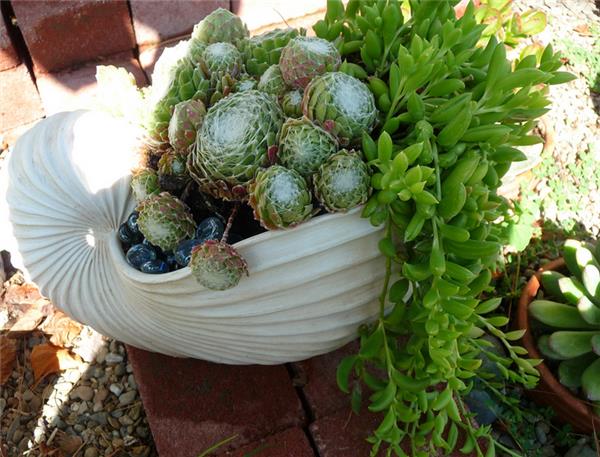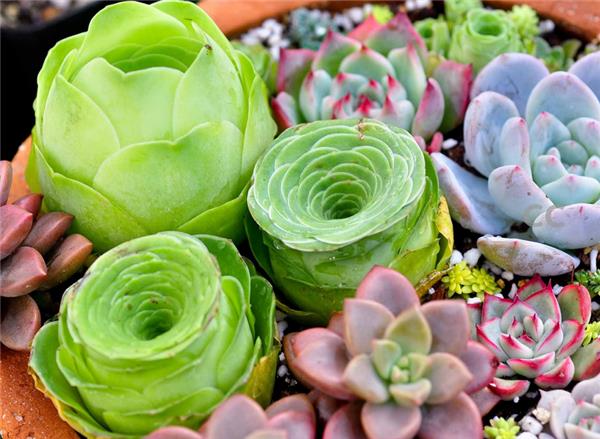Methods of controlling insect pests by succulent plants
Succulent plants are easy to be harmed by insects, so let's introduce the pest control methods of succulent plants in detail.

Methods of controlling insect pests by succulent plants
1. Red spider
The main game endangers the family Euphorbiaceae and Euphorbiaceae. Succulent plants of Compositae and Liliaceae. Suck the juice of young stems and leaves with mouthparts, and the injured leaves show yellowish-brown stains or withered yellow and fall off. This scar never fades. Generally speaking, you can see if there are cobwebs on the back of the leaves, and there are very small red / white / dark worms. If there is, it's usually a red spider.
Prevention and control measures can be used to increase environmental humidity, reduce and avoid spread, can be killed by 1000-1500 times of dicofol, or avermectin.
two。 Shell worm
The damage is very wide. It often harms the succulent plants such as tequila and Twelve genera with compact arrangement of leaves, sucking the sap of stems and leaves, resulting in poor growth of plants and withering and death in serious cases. Its high incidence period is earlier than that of red spiders and often multiplies in large numbers in early spring. But its harm is also easy to control, that is, it is often concentrated on a small number of plants, sometimes one plant is covered with scale insects, but the neighboring one has none.
Prevention and control measures: when the quantity is small, it can be removed with a brush. In addition, it can also be killed with 800-1000 times liquid spray. Mixed with a certain amount of carbofuran in the culture soil has a preventive effect, but the effect is only 3 months.
3. Whitefly
The harm is small, and it often occurs in the shrubby succulent plants of Euphorbiaceae, such as Caiyun Pavilion, Tiger prickly Plum, Jade Kirin, Dijin and so on, which thorns and absorbs juice on the back of the leaves, resulting in yellowing and shedding of leaves and coal fouling at the same time. There will be a large piece of ugly black powder on the stems and leaves, which will directly affect the ornamental value of the plant.
Prevention and control measures: in addition to improving environmental ventilation, 40% omethoate EC can be sprayed at the initial stage with 1000-2000 times liquid, and can also be sprayed with marathon 500 times liquid or dimethoate mixed dichlorvos 1000 times liquid. After spraying for 2 days, the dead insects together with black powder can be washed away with strong water flow.

4. Aphids
Most succulent plants that harm crassulaceae and Compositae often suck the juice of the young parts of the plant, causing plant growth to decline, and their secretions also attract the invasion of ants.
Prevention and control measures: if the number is small, you can hunt and kill manually and pinch one at a time. Spraying with 1500 times of 80% dichlorvos EC at the initial stage of damage, German Bayer-imidacloprid can also be considered.
This is the end of the introduction on the control methods of succulent plant pests, and then take a look at the prevention and control of succulent plant diseases.
1. Scab
☆ disease is prohibited for bacterial ☆, which is the main disease of succulent plants. It often harms succulent plants with tubers and invades people from the root wound, resulting in red color spots on the tubers, which rot and die after several deaths.
Prevention and control measures: spray 1000 times solution of topiramine wettable powder before potting, and apply sulfur powder to disinfect it after drying.

two。 Anthrax
It is an important disease that harms succulent plants. It belongs to fungal ☆ to prohibit ☆ disease. It often occurs in the hot and humid season, especially in the hot and humid plum rain season. Excessive application of nitrogen fertilizer may also cause. Small brown patches appeared in the leaves at the initial stage of the disease, and then expanded into a circular or oval shape. The disease spot gradually dried up, and in severe cases, the whole plant was invaded.
Prevention and control measures: first of all, it is necessary to open windows for ventilation to reduce indoor air depression and humidity. Then use 70% thiophanate methyl wettable powder 1000 times liquid spray, or spray 70% methyl thiophanate 60% anthrax, multi-bacteria, etc., to prevent the disease from spreading.
3. Purulent disease
It often occurs in succulent plants of Euphorbiaceae. Large rust-brown disease spots appear on the epidermis of the stem and spread upward from the base of the stem. In severe cases, the stem is covered with disease spots.
Prevention and treatment: can be combined with pruning, cut off the diseased branches, let them re-germinate new branches, and then spray with 12.5% uniconazole wettable powder 2000-3000 times.
4. Physiological ☆ prohibits ☆ disease
Due to the harsh planting environment, such as strong light exposure, serious lack of light, sudden low temperature and long-term lack of water, resulting in burns, browning, excessive growth of stem and leaf epidermis, frostbite of some tissues, tip shrinkage and so on, the most fundamental measure is to improve the cultivation conditions.

Control methods of succulent plant diseases and insect pests
The prevention and control of succulent plant diseases and insect pests is mainly based on prevention. First of all, the environment should be clean and tidy. Foreign succulent plants must be strictly checked and put into the shed only when they are sure that there are no diseases and insect pests. Seasonal handover is a season prone to diseases and insect pests. Generally speaking, when the weather changes from "cold to warm" and "from hot to cool", it is the time when diseases and insect pests are most likely to break out suddenly. In addition, just after summer, the succulent plants have just passed a long dormant period and are gradually resuming their growth, but their physiological functions have not fully recovered, and their resistance is still in a very weak stage, so they are easily invaded by diseases and insect pests. concentrated spraying in the shed before early winter, early spring and Meiyu has twice the result with half the effort. In addition, it has a good preventive effect on the disinfection of cultured soil.
The fungicides commonly used in succulent plants are mainly fungicides for disease prevention and treatment (such as carbendazim, thiophanate, chlorothalonil, Dysen zinc, etc.) and insecticides (such as omethoate, acaryl alcohol, marathon, fenvalerate, avermectin, etc.). The concentration of the insecticide should be controlled strictly according to the instructions, especially the insecticide, which will cause drug damage if the concentration is a little higher, which is particularly sensitive to Diguan and some Euphorbiaceae succulent plants.
Seasonal handover is a season prone to diseases and insect pests. Generally speaking, when the weather changes from "cold to warm" and "from hot to cool", it is the time when diseases and insect pests are most likely to break out suddenly. In addition, just after summer, the succulent plants have just passed a long dormant period and are gradually resuming their growth, but their physiological functions have not fully recovered, and their resistance is still in a very weak stage, so they are easily invaded by diseases and insect pests. concentrated spraying in the shed before early winter, early spring and Meiyu has twice the result with half the effort. In addition, it has a good preventive effect on the disinfection of cultured soil.
The fungicides commonly used in succulent plants are mainly fungicides for disease prevention and treatment (such as carbendazim, thiophanate, chlorothalonil, Dysen zinc, etc.) and insecticides (such as omethoate, acaryl alcohol, marathon, fenvalerate, avermectin, etc.). The concentration of the insecticide should be controlled strictly according to the instructions, especially the insecticide, which will cause drug damage if the concentration is a little higher, which is particularly sensitive to Diguan and some Euphorbiaceae succulent plants.
Related
- Wuhan Hospital Iron Tree Blooming Result Was Instantly Frightened by the Gardener Master
- Which variety of camellia is the most fragrant and best? Which one do you like best?
- What is the small blue coat, the breeding methods and matters needing attention of the succulent plant
- Dormancy time and maintenance management of succulent plants during dormancy
- Minas succulent how to raise, Minas succulent plant pictures
- What are the varieties of winter succulent plants
- How to raise succulent plants in twelve rolls? let's take a look at some experience of breeding twelve rolls.
- Attention should be paid to water control for succulent plants during dormant period (winter and summer)
- Watering experience of twelve rolls of succulent plants
- Techniques for fertilizing succulent plants. An article will let you know how to fertilize succulent plants.



